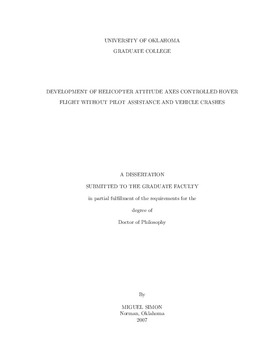| dc.contributor.advisor | Stalford, Harold L., | en_US |
| dc.contributor.author | Simon, Miguel. | en_US |
| dc.date.accessioned | 2013-08-16T12:20:39Z | |
| dc.date.available | 2013-08-16T12:20:39Z | |
| dc.date.issued | 2007 | en_US |
| dc.identifier.uri | https://hdl.handle.net/11244/1195 | |
| dc.description.abstract | In this work, we show how to computerize a helicopter to fly attitude axes controlled hover flight without the assistance of a pilot and without ever crashing. We start by developing a helicopter research test bed system including all hardware, software, and means for testing and training the helicopter to fly by computer. We select a Remote Controlled helicopter with a 5 ft. diameter rotor and 2.2 hp engine. We equip the helicopter with a payload of sensors, computers, navigation and telemetry equipment, and batteries. We develop a differential GPS system with cm accuracy and a ground computerized navigation system for six degrees of freedom (6-DoF) free flight while tracking navigation commands. We design feedback control loops with yet-to-be-determined gains for the five control "knobs" available to a flying radio-controlled (RC) miniature helicopter: engine throttle, main rotor collective pitch, longitudinal cyclic pitch, lateral cyclic pitch, and tail rotor collective pitch. | en_US |
| dc.description.abstract | We develop helicopter flight equations using fundamental dynamics, helicopter momentum theory and blade element theory. The helicopter flight equations include helicopter rotor equations of motions, helicopter rotor forces and moments, helicopter trim equations, helicopter stability derivatives, and a coupled fuselage-rotor helicopter 6-DoF model. The helicopter simulation also includes helicopter engine control equations, a helicopter aerodynamic model, and finally helicopter stability and control equations. The derivation of a set of non-linear equations of motion for the main rotor is a contribution of this thesis work. | en_US |
| dc.description.abstract | After discussing the integration of hardware and software elements of our helicopter research test bed system, we perform a number of experiments and tests using the two specially built test stands. Feedback gains are derived for controlling the following: (1) engine throttle to maintain prescribed main rotor angular speed, (2) main rotor collective pitch to maintain constant elevation, (3) longitudinal cyclic pitch to maintain prescribed pitch angle, (4) lateral cyclic pitch to maintain prescribed roll angle, and (5) yaw axis to maintain prescribed compass direction. (Abstract shortened by UMI.) | en_US |
| dc.description.abstract | We design and build two special test stands for training and testing the helicopter to fly attitude axes controlled hover flight, starting with one axis at a time and progressing to multiple axes. The first test stand is built for teaching and testing controlled flight of elevation and yaw (i.e., directional control). The second test stand is built for teaching and testing any one or combination of the following attitude axes controlled flight: (1) pitch, (2) roll and (3) yaw. The subsequent development of a novel method to decouple, stabilize and teach the helicopter hover flight is a primary contribution of this thesis. | en_US |
| dc.description.abstract | The novel method included the development of a non-linear modeling technique for linearizing the RPM state equation dynamics so that a simple but accurate transfer function is derivable between the "available torque of the engine" and RPM. Specifically, the main rotor and tail rotor torques are modeled accurately with a bias term plus a nonlinear term involving the product of RPM squared times the main rotor blade pitch angle raised to the three-halves power. Application of this non-linear modeling technique resulted in a simple, representative and accurate transfer function model of the open-loop plant for the entire helicopter system so that all the feedback control laws for autonomous flight purposes could be derived easily using classical control theory. This is one of the contributions of this dissertation work. | en_US |
| dc.format.extent | xxxiii, 488 leaves : | en_US |
| dc.subject | Helicopters Control systems. | en_US |
| dc.subject | Engineering, Aerospace. | en_US |
| dc.subject | Feedback control systems. | en_US |
| dc.subject | Engineering, Robotics. | en_US |
| dc.subject | Engineering, Mechanical. | en_US |
| dc.subject | Drone aircraft. | en_US |
| dc.title | Development of helicopter attitude axes controlled hover flight without pilot assistance and vehicle crashes. | en_US |
| dc.type | Thesis | en_US |
| dc.thesis.degree | Ph.D. | en_US |
| dc.thesis.degreeDiscipline | School of Aerospace and Mechanical Engineering | en_US |
| dc.note | Adviser: Harold L. Stalford. | en_US |
| dc.note | Source: Dissertation Abstracts International, Volume: 68-04, Section: B, page: 2474. | en_US |
| ou.identifier | (UMI)AAI3261118 | en_US |
| ou.group | College of Engineering::School of Aerospace and Mechanical Engineering | |
